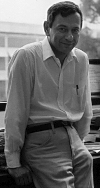
Professor; BA, Hebrew University, Jerusalem, Israel; PhD, Weizmann Institute of Science, Rehovot, Israel; Postdoctoral Scholar, Biology Department, The Johns Hopkins University.
Research Description
Work done by muscle and non-muscle cells requires the transduction of chemical into mechanical energy. This function is carried out by a cellular contractile apparatus which contains actin and myosin as well as other proteins. The interactions between these proteins and the changes in their structure constitute the molecular basis for force generation in muscle and non-muscle cells. Our goal of elucidating the mechanism of contractile processes is pursued at two levels. At the molecular level we are concerned with the structural and dynamic properties of the contractile proteins. We explore structure-function relationships in actin, myosin and other proteins by biochemical, biophysical, immunochemical, and biological approaches. Intermediate steps in the contractile process are probed with the help of nucleotide analogues, specific antibodies, synthetic peptides, and appropriate mutants of the key proteins. At the cellular level, we study the function, interactions, and structural transitions of assembled protein systems.
Many filamentous cellular structures are constructed from their components through fine-tuned assembly processes. The biological function of these filaments is frequently linked to the regulation of this assembly by cellular factors. Our interest is focused on the formation of myosin and actin filaments from their monomeric protein units. The mechanisms of the assembly reactions and the structural changes which govern the polymerization reactions are studied by biophysical, biochemical, and electron microscopy methods. To understand the regulation of actin and myosin assembly by other proteins, macromolecular contact sites are investigated by a wide spectrum of experimental techniques.
key words
Biochemistry: muscle contraction; cell motility; regulation of contraction; actin, myosin, and regulatory proteins; macromolecular interactions; assembly of filamentous structures; regulation of assembly.